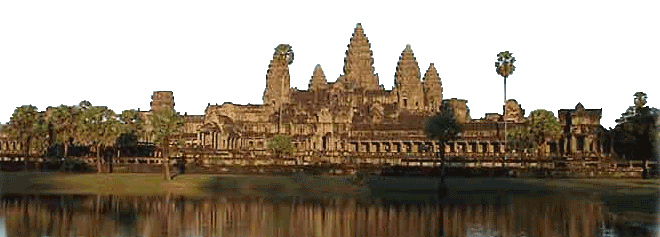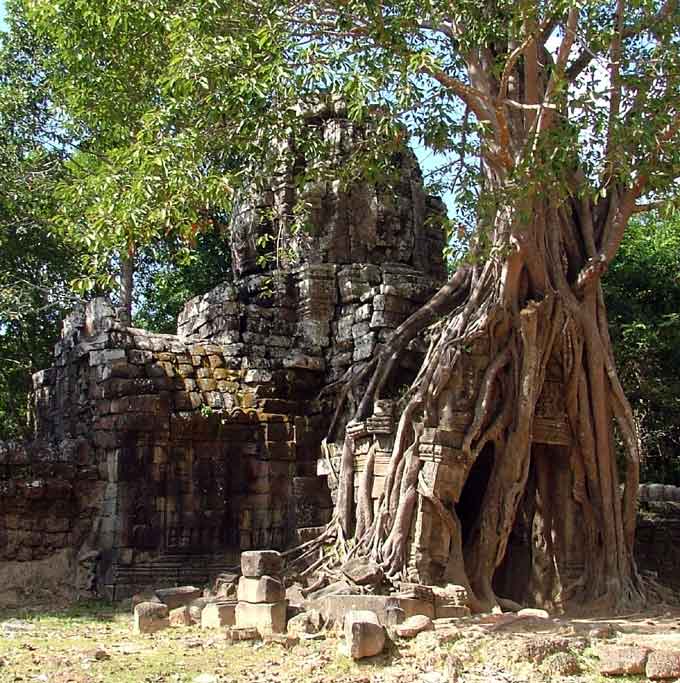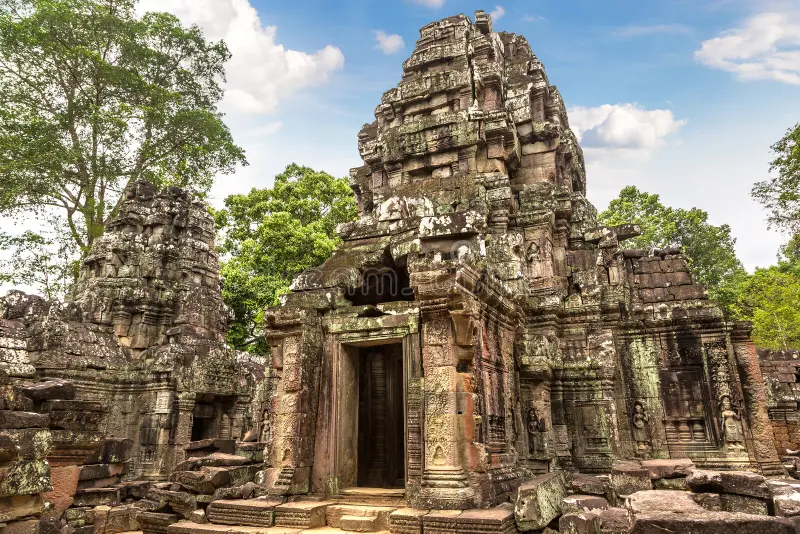Cambodge Temple d'Ankor - Ta Som

Cambodge temple d'Angkor
TA SOM**
Constructed Late 12 th century
Religion : Buddhist
Style Bayon
King Jayavarman VII
Location:
On the Grand Circuit, north of the Eastern Baray
Comment:
The "Ta Som" temple is a remarkable site dating back to the 12th century. It was built during the reign of King Jayavarman VII, who also erected several other emblematic monuments of the Khmer Empire.
Ta Som is a small Buddhist temple, built of sandstone, characteristic of Angkorian buildings of this period. The main structure comprises a central sanctuary surrounded by a perimeter wall, with an outer gallery leading to the altar. The design is typical of Khmer temples, with a stepped pyramid leading to the sanctuary, symbolizing the mythical mountain of Indra.
The west gate of the temple is famous for the large tree (Ficus) that has grown through it, creating a picturesque and mysterious scene. The stone structure is partially covered by vegetation, giving the site a wild and timeless appearance. Although less ornate than other temples such as Angkor Wat or Bayon, Ta Som features sculptures depicting Hindu (notably Shiva) and Buddhist deities, illustrating the religious transition in the region.
Ta Som is a representative example of late 12th-century architecture, illustrating the political and religious transition from Hinduism to Buddhism in the Khmer Empire. Built under Jayavarman VII, who favored Mahayana Buddhism, the temple reflects this period of religious change.
The site is smaller and less frequented than other major monuments of Angkor, giving it an intimate and mysterious atmosphere. The vegetation that invades the site, particularly the famous tree at the west gate, adds to its natural charm and symbolizes nature reclaiming its former human architecture.
Localisation :
Sur le grand circuit, au nord du baray oriental
Commentaire :
Le temple « Ta Som » est un site remarquable datant du XIIe siècle, il a été construit sous le règne du roi Jayavarman VII, qui a également édifié plusieurs autres monuments emblématiques de l’Empire khmer.
Ta Som est un petit temple bouddhiste, construit en pierre sandstone, caractéristique des constructions angkoriennes de cette période. La structure principale comprend un sanctuaire central entouré d’un mur d’enceinte, avec une galerie extérieure qui mène à l’autel. La conception est typique des temples khmers, avec une pyramide à degrés menant vers le sanctuaire, symbolisant la montagne mythique d’Indra.
La porte ouest du temple est célèbre pour le grand arbre (Ficus) qui a poussé à travers elle, créant une scène pittoresque et mystérieuse. La structure en pierre est partiellement recouverte par la végétation, donnant au site un aspect sauvage et intemporel.
Bien que moins ornés que d’autres temples comme Angkor Wat ou Bayon, Ta Som possède des sculptures représentant des divinités hindoues (notamment Shiva) et bouddhistes, illustrant la transition religieuse dans la région.
Ta Som est un exemple représentatif de l’architecture de la fin du XIIe siècle, illustrant la transition politique et religieuse de l’hindouisme vers le bouddhisme dans l’Empire khmer. Construit sous Jayavarman VII, qui a favorisé le bouddhisme mahāyāna, le temple reflète cette période de changement religieux.
Le site est moins grand et moins fréquenté que d’autres monuments majeurs d’Angkor, ce qui lui confère une atmosphère intime et mystérieuse. La végétation qui envahit le site, notamment le célèbre arbre à la porte ouest, ajoute à son charme naturel et symbolise la nature qui reprend ses droits sur l’ancienne architecture humaine.




